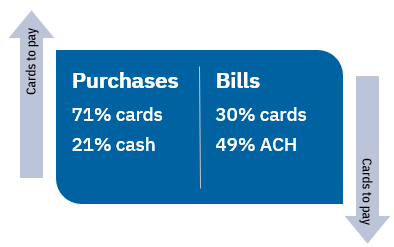Cards are the dominant players in consumer payments. In 2019, this blog called cards the "patriots of the payments landscape," and that assessment holds true today.
According to October 2022 data from the Survey and Diary of Consumer Payment Choice:
- 98 percent of US consumers have some sort of payment card (debit, credit, or prepaid), more than the 94 percent who have a bank account.
- 93 percent of consumers used some sort of card in the 30 days ending in October 2022, more than made an ACH payment (65 percent) or paid with cash (83 percent).
- 63 percent of payments made by consumers in October 2022 by number were with cards.
If we all love cards so much, why are cards relatively rare for bill pay? We made seven out of 10 purchases with cards in October 2022 and just three in 10 bill payments.

I think you know the answer. In a two-sided market like payments, payer and payee must agree on how to conduct a transaction.
- We consumers have more leverage at the retail point of sale, whether online or in person. Retailers are loathe to restrict our payment choice, because we're making the decision about how to pay simultaneously with the decision to purchase.
- For bill pay, our buying decisions are in the past. That gives the biller a bit more leeway to require or steer us toward a particular payment choice, often related to the cost of acceptance. For example, my power company won't accept payment by credit card. And my local government charges a fee to accept payment with a debit card. With an ACH payment, the fee is waived.
In addition, and outside the buyer's or seller's purview, we cannot repay a debt with a credit card, which eliminates one payment option for mortgage payments, car loans, and other debt.
The 2022 data was released in early August, and you can explore it on our website.



